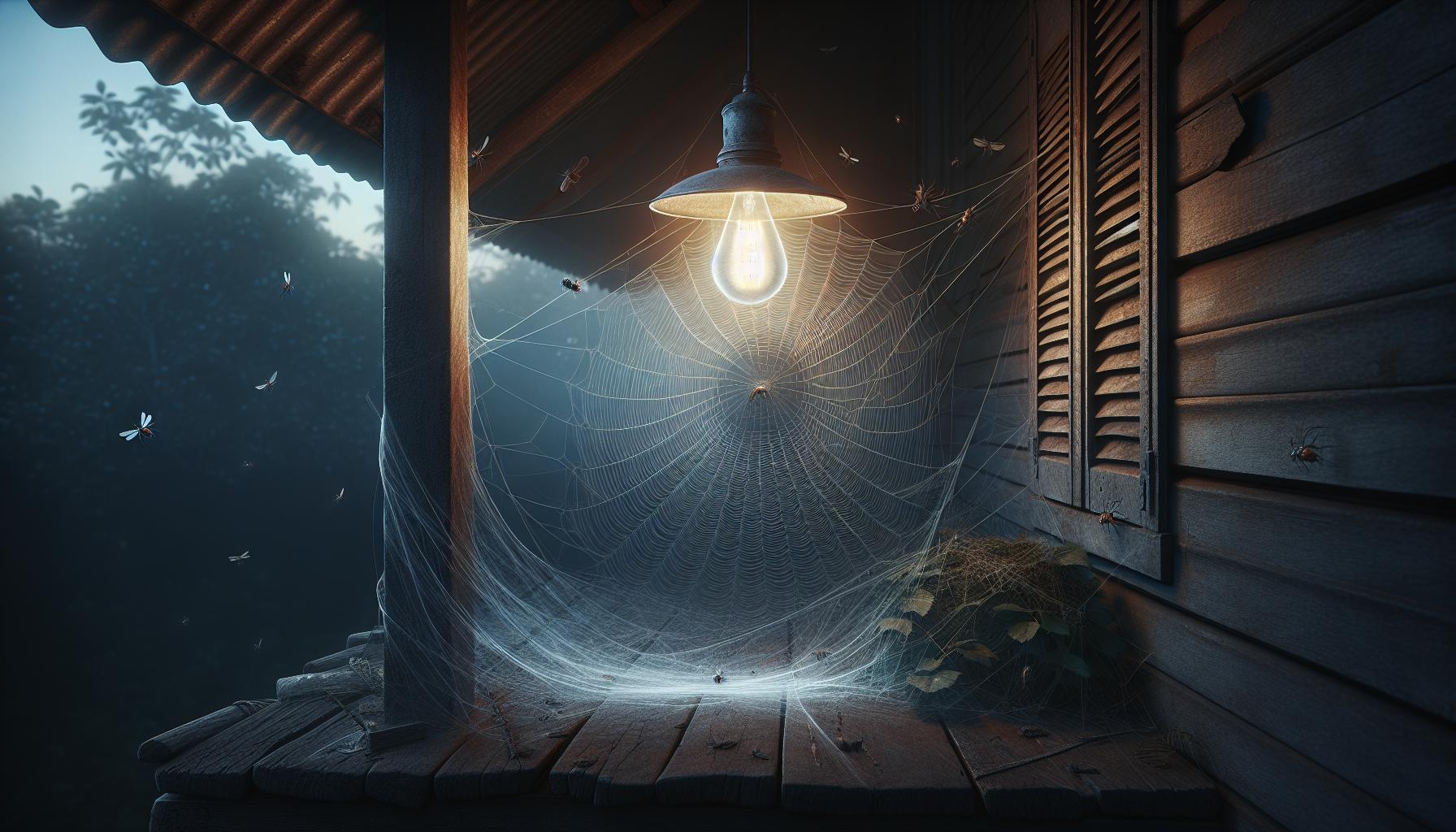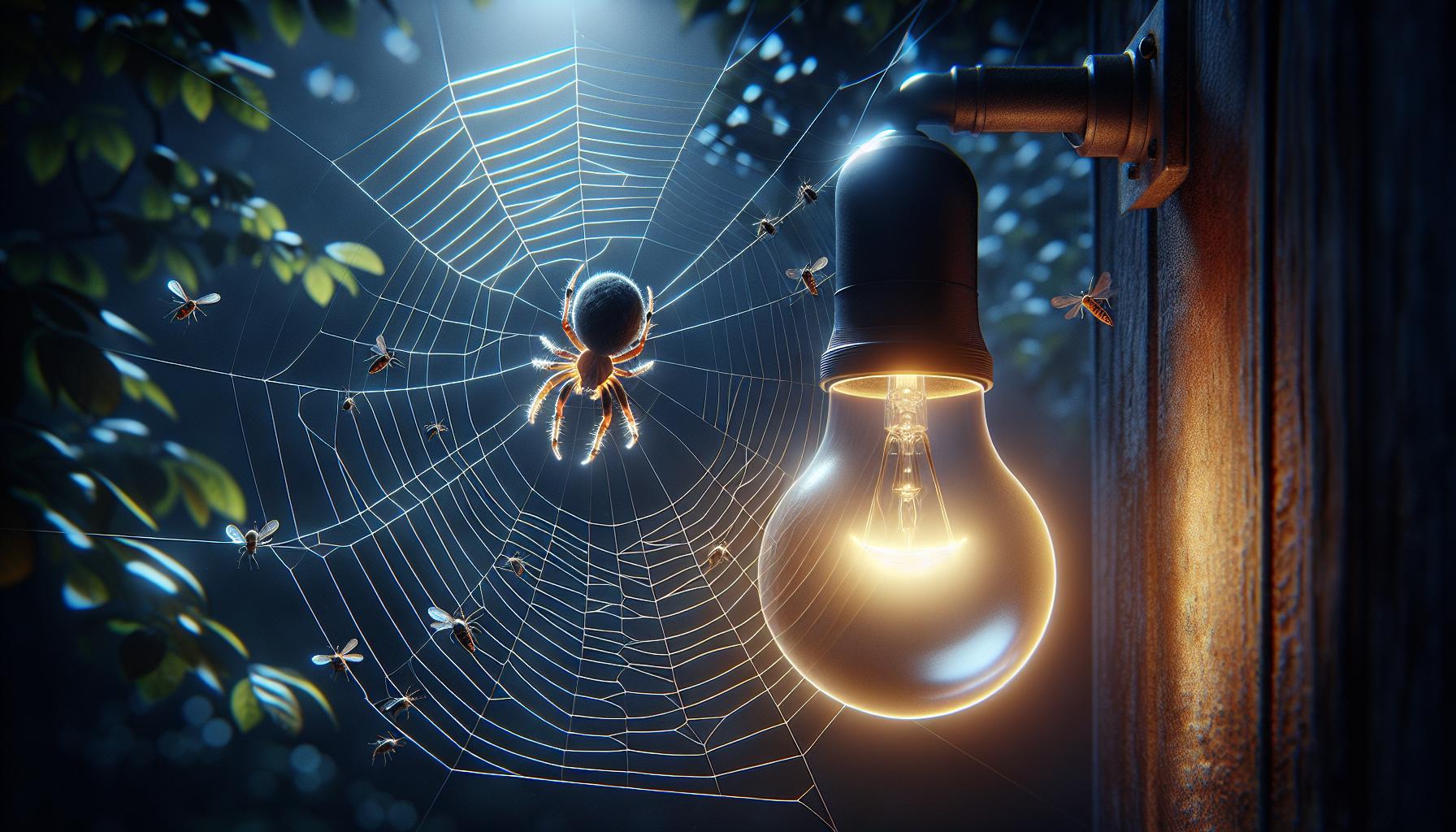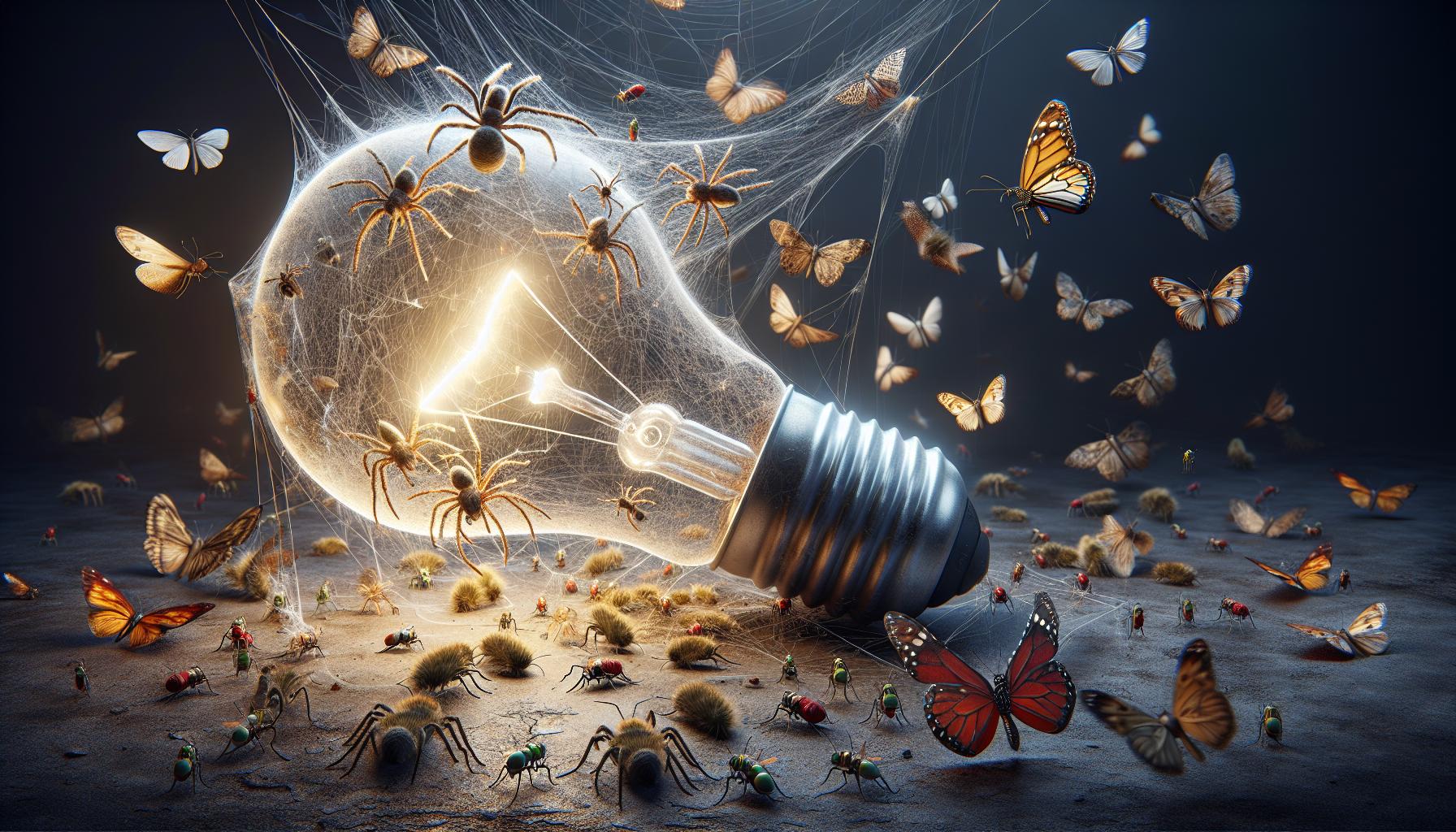Ever noticed how spiders seem to set up shop around your porch light or lamp posts? It’s like they’re throwing a nightly party, and every bug in the neighborhood is invited. But have you ever wondered if it’s the light itself that spiders are drawn to?
Turns out, the answer isn’t as straightforward as you might think. Spiders are crafty creatures, and there’s a bit more going on than meets the eye. Let’s shed some light on this intriguing topic and find out what’s really attracting these eight-legged architects to our glowing bulbs.
Spiders and Light: The Curious Connection
Have you ever noticed how spiders seem to set up shop near your outdoor lights? As a DIY enthusiast with a penchant for lighting, you might find this more than a little interesting. But why are spiders drawn to illuminated areas if they don’t have an intrinsic fascination with the bulb itself?
The answer lies in the food chain. Spiders are tactical predators, and light bulbs are perfect for setting up their traps. It’s not the light that spiders are after; it’s the buffet of insects that are attracted to the brightness of your porch or lamp post lights. For these eight-legged architects, a well-lit area is akin to a dinner bell for insects, and subsequently, a gathering spot for their next meal.
Let’s break down the relationship between spiders, light bulbs, and their prey:
- Light sources attract all sorts of nocturnal insects.
- Insects swarm light bulbs due to their natural navigation systems getting confused.
- Spiders recognize these areas as prime feeding grounds.
You’ve probably experienced the frustration of buzzing insects during a late-night porch sitting. This is the exact scenario spiders exploit. While you’re swapping out bulbs, spiders are biding their time, anticipating the arrival of their winged snacks.
Here’s a bit of trivia: not all light bulbs are equal in the eyes—or should we say, the many eyes of spiders. Your typical incandescent bulb is significantly more attractive to insects than, say, yellow-tinted or warm LED lights. If you’re a home DIY buff, consider experimenting with different lighting options to minimize the allure for both insects and, by extension, spiders.
By understanding this curious connection, you can better manage your outdoor lighting and perhaps reduce the spider population around your home. Rather than battling the spiders directly, you could adapt your lighting strategy to make your outdoor space less inviting for their prey. After all, if there’s no food to be caught, why set up the web? Still, remember, having a few spiders around can be beneficial—they’re nature’s own pest control after all.
Understanding Arachnid Behavior
You’re standing under the warm glow of your porch light, admiring the stellar work you’ve done with your latest DIY light fixture, when you notice the intricate web of a spider glistening in the corner. You may wonder, “Do these eight-legged creatures actually like the light bulbs, or is there something else at play?”
Spiders themselves aren’t attracted to the light. Instead, they are savvy predators that capitalize on the fact that porch lights are insect magnets. Insects, the primary prey for many spider species, are drawn to these illumination oases in the darkness. This inadvertently creates a hunting ground for spiders. Your lighting choices matter more than you might think in influencing this behavior.
When it comes to the types of light bulbs, incandescent bulbs tend to attract more insects due to their warmth and spectrum of light, which closely mimics natural light sources like the sun and moon. On the flipside, bulbs such as sodium vapor lamps or warm LED lights tend to be less attractive to both insects and spiders due to their color and temperature, which don’t lure in insects quite as effectively.
As a lighting enthusiast, you’ll find that the brightness and placement of bulbs around your home play a critical role as well. Bright lights are like beacons for nocturnal insects. So, consider these strategies:
- Use dimmer lights where possible.
- Position lights away from doorways and sitting areas.
- Choose bulb types that emit wavelengths less visible to insects.
Next time you’re selecting bulbs or adjusting your outdoor lighting setup, keep these tips in mind to keep the insect and spider populations at bay. Your choice could make all the difference in the ambiance of your outdoor spaces and the biodiversity that inhabits them. Opting for specific lighting solutions is an integral part of any home DIY project that seeks harmony with the natural world.
The Draw of Illumination
« Why Are My Light Bulbs So Hot? Stay Cool with These 5 Fixes
What Light Bulbs Are Best for Your Eyes? Discover Eye-Soothing Picks »
As you delve deeper into the nuances of residential lighting, you’ve probably noticed your outdoor lights buzzing with activity on a warm evening. It’s not just your imagination; there’s a science behind the spectacle. The iridescence of artificial lights doesn’t just brighten your yard, it sets the stage for an insect jamboree, which, in turn, attracts the eight-legged patrons.
Think of your outdoor lights as a beacon in the night. Insects are naturally attracted to light sources, a phenomenon known as phototaxis. This inadvertent invitation lures in a smorgasbord of bugs, and where there’s food, predators follow. Spiders, being the savvy hunters they are, make their way to these illuminated spots to feast. So, it’s not the light bulbs themselves that spiders are interested in; it’s the buffet that comes with them.
- Insects attracted by light: Moths, flies, beetles
- Predators: Spiders, primarily nocturnal species
- Light types: Incandescent bulbs attract more insects
Keeping this in mind, let’s explore your lighting choices. Incandescent bulbs are renowned for their warm glow, a feature that’s like a magnet for insects. However, if you’re a fan of the vintage feel of these bulbs but not the critters they attract, there might be a compromise. LED bulbs have come a long way, and newer models emit a spectrum of light that’s less visible to insects yet pleasing to the human eye.
The placement of your lights can help manage this interplay. Positioning lights strategically can draw insects away from areas you frequent, thus redirecting the spiders’ hunting grounds. Here are some quick tips:
- Place lights away from doorways and windows: This will reduce the number of insects and spiders entering your home.
- Use shielded light fixtures: These direct light downwards and reduce the spread across your yard.
- Opt for warm-colored LED bulbs: They attract fewer insects than their cooler-colored or incandescent counterparts.
Remember, your lighting choices do more than just illuminate; they influence the local ecosystem right in your backyard. Whether you’re a DIY enthusiast or a peaceful backyard occupier, understanding the draw of illumination is the key to coexisting with nature’s nightly rituals.
Light Bulbs as Hunting Grounds
You’ve probably noticed how your porch light seems to host a tiny ecosystem of its own every night. If you’re keen on observing, you’ll see that light bulbs are more than just beacons in the dark. They’re prime hunting grounds for spiders. But why? It’s all about the light’s allure to prey.
As a home DIY enthusiast and lighting expert, you’re aware that bulbs emit various light spectrums, but did you know those spectrums are an open invitation to a feast for spiders? Insects can’t resist the glow of a warm bulb, and so, spiders have learned that light fixtures are the perfect spots to snag a meal. Think of it as a dinner bell for nocturnal hunters with eight legs.
When designing your outdoor lighting, it’s helpful to understand how spiders monopolize this. They aren’t there for the light itself but for the smorgasbord it provides. LED bulbs are particularly interesting in this dynamic because they tend to attract fewer insects. Still, the question remains: do the spiders know? There hasn’t been concrete evidence to suggest that spiders can distinguish between bulb types, but their presence around even LEDs indicates that if there’s even a small number of insects, it’s enough.
Here are some DIY tips to minimize this ecosystem:
- Use bulbs that emit light at shorter wavelengths like yellow or red, which are less attractive to both insects and hence to spiders.
- Place outdoor lights further from your living spaces to keep the nightly hunter-gatherer drama away from your doorstep.
- Consider using motion sensors or timers to limit the time lights are on, thus reducing the window of opportunity for insects and spiders.
Remember, it’s not about eliminating the food web that forms around your outdoor lights; it’s about managing it. With clever lighting choices and strategic placement, you can enjoy your evenings without an arachnid audience.
The Truth Behind Spider Attraction
You might have noticed spiders spinning their webs in corners of your porch or near outdoor lighting fixtures. It’s easy to wonder, do spiders actually like the light bulbs themselves, or is there something else at play here? Let’s shed some light on this intriguing behavior.
Spiders don’t seek out light bulbs because they love the glow. In fact, these eight-legged creatures are not drawn to the light at all—they’re after the bounty that the light provides. Light bulbs attract a smorgasbord of insects, and spiders are simply taking advantage of this easy meal delivery system. Think of it as an all-you-can-eat buffet, courtesy of your patio light.
When you illuminate your yard with traditional light bulbs, you’re unknowingly setting the stage for an insect free-for-all. And with an abundant supply of moths, flies, and other small insects, spiders set up shop nearby. Their webs are strategically spun where the traffic is heaviest, often around lights where their prey is most active.
| Strategy | Benefits |
|---|---|
| Use non-attractive LED | Fewer insects are drawn |
| Shield your lights | Direct light downwards, minimizing insect and spider attraction |
| Motion sensors | Lights are only on when needed, reducing continuous insect draw |
Avid DIY enthusiasts like you can leverage these strategies to keep your outdoor spaces spider-free. Swap out those bulbs for ones that emit less insect-friendly light, shield your lights so only the intended areas are illuminated, and consider installing motion sensors or timers to reduce the overall attraction to these areas.
Understanding spider behavior is key in coexisting with these natural predators. They’re an important part of the ecosystem, controlling pest populations. So while you might not want them directly outside your window, it’s worth considering the balance they bring to your backyard habitat. Plus, they provide free pest control—who wouldn’t want that?
Remember, it’s less about spiders liking light bulbs and more about what light bulbs inadvertently invite to the party. Adjust your lighting fixtures and enjoy the perks of an outdoor space that’s both welcoming to friends and family and less enticing to the arachnid community. With the right approach, you can achieve that delicate balance that celebrates the nocturnal dance between predator and prey, without turning your home into an unintended insect bistro.
Conclusion
So you’ve got the scoop on spiders and their attraction to your outdoor lights. Remember, it’s not the glow they’re after but the buffet of bugs that your porch light serves up every night. With a few tweaks to your lighting setup, you can keep those eight-legged guests at bay. Whether you switch to shorter wavelength bulbs, reposition your lights, or get savvy with sensors and timers, you’re taking a step towards a more spider-free zone. It’s all about striking a balance with nature right outside your door. Happy lighting—and less spider sighting!
Frequently Asked Questions
Why are there more spiders around my outdoor lights?
Spiders are attracted to outdoor lights due to the increased presence of insects that are drawn to the light, not the light itself.
What type of bulbs can reduce the attraction of insects and spiders?
Bulbs that emit light at shorter wavelengths, like yellow or red-tinted lights, can help minimize the attraction of insects and consequently spiders.
How can I keep spiders away from living spaces outside?
Position outdoor lights further away from living spaces, and use lighting fixtures that direct light downward to reduce the range at which insects and spiders are attracted.
Do motion sensors and timers help with spider problems?
Yes, motion sensors and timers can help by limiting the time outdoor lights are on, thus reducing the window of opportunity for insects and spiders to gather around the lights.
Is it better to eliminate all insects and spiders around outdoor lights?
Eliminating the entire ecosystem around outdoor lights is not recommended. Instead, manage it by using appropriate lighting and positioning to minimize nuisance while maintaining ecological balance.




